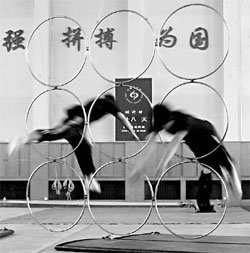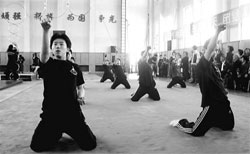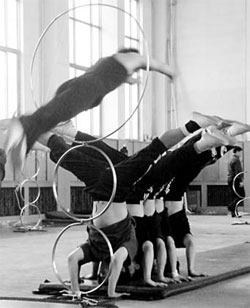Quantum leaps
|
Acrobatics majors at the Beijing International Art School flip through loops beneath a sign reading "Fight for the nation" at China's first-ever acrobatics open house. |
More than 130 members of the public visited the Beijing International Arts School, where they toured gymnasiums filled with training acrobats spinning plates, flipping through hoops and performing fantastic feats with kongzhu a yoyo-like toy with a Chinese spin.
The admission-free open house was also intended to get Beijing buzzing about its upcoming show, Splendid Picture Scroll. The show, which will run from April 27 to 29 at Beizhan Theatre and from May 4 to 7 at Poly Theatre, will showcase the troupe's most popular stunts.
"We hope to help Chinese audiences gain a better understanding of this performance art. They can see how the shows are prepared, how they do their training and what their lives are like backstage," said Ma Nan, CNAT's foreign marketing assistant.
"Many people are familiar with Chinese acrobatics, however, they only think of it as a traditional type of art. But today, Chinese acrobatics are developing, and many people haven't yet seen the modern incarnation."
Director of CNAT Li Enjie said that Chinese acrobatic troops must work to advance the performance art while maintaining personal connections with audiences.
|
Students rehearse choreography, an increasingly important component of modern Chinese acrobatic shows. |
"Chinese acrobatics have a history of 3,000 years, and the reason that acrobatics have succeeded in China for such a long time is exactly because of that connection with the audience," said director Li. "This kind of open house is the first of its kind. We were wondering if people were going to attend, but the fact that we ended up with a full house demonstrates the depth of this connection."
Beijinger Zhang Baopan, 69, said he came to the open house because he has been an acrobatics aficionado for decades. He attracted a small but excited crowd around him when he showcased several of his souvenir program lists which dated back as far back as 1976.
"Since I started attending these shows, the acrobatics programs have become more sophisticated, and there have been huge improvements made in the costumes, props and organization of the shows," Zhang said. "And the future looks even brighter, because the direction of the development of acrobatics is moving toward even greater levels of sophistication and complexity."
|
A student leaps through loops and flips over classmates performing headstands. |
"The amazing thing about mixing art and acrobatics is that anything you can imagine, you can do," He said. "In all ways, including the artistic element, this upcoming show will incorporate elements that show the changing face of acrobatics in China. The most important thing is to show audiences what modern Chinese acrobatics are like in order to change their traditional conceptions."
After touring the facilities, visitors were invited to attend a presentation and Q&A session with the minds behind the troupe's stage shows. Visitors were also given door prizes including free tickets, coupons and copies of a book written by the troupe's oldest performer, 80-year-old Jin Yeqing, entitled I'm Stepping Out of Tianqian.
Jin shared with attendees his experiences with the troupe, including its founding on October 20, 1950, which came about at the request of Premier Zhou Enlai.
"Zhou asked us: 'What's the name of your performance?' We told him we didn't have one. He said: 'Maybe you should call it zaji,'" Jin said, adding that when he performed in Moscow a year later, he found the word for the first time in a Russian-Chinese dictionary.
Today, the ancient word, which translates to "a collection of trivial talents", is the most common term for Chinese acrobatics, and has taken on more prestigious connotations as the status of professional acrobats has risen in Chinese society.
But Chinese acrobatics' rise in status isn't merely a domestic phenomenon.
Beijinger Wang Jingxuan said his reason for attending the open house was to congratulate the performers on their recent success in raking in international awards and to thank their instructors for their hard work. The troupe recently scooped six international awards in Hungary, Monaco, Russia and Poland, and He, the art director, won first place in the 26th Gold Clown World Acrobatic Competition.
Most of the troupe's performers are recruited from the Beijing International Arts School, where those who major in acrobatics study five to eight hours a day, five days a week. Among the 200 some students are 40 foreign students, about half of which come from Russia and Myanmar, while the rest are from the United States, the United Kingdom, Australia and Eastern Europe.
"These foreign students bring with them techniques from their home countries, which has made a great contribution to Chinese acrobatics," said Zuo Qiang, head of the school's acrobatics department. "If all of us study together, we can find a common understanding of what acrobatics are."
Pyeat Phyo Oo, 17, came from Myanmar a year ago to study acrobatics in Beijing.
"I like acrobatics, so I came to China because I knew it was a good place to study it," he said in the broken Chinese he picked up at the school.
Zuo said that during the initial stages of their training, foreign students such as Pyeat are provided with translators to help them learn the more technical points of Chinese acrobatic jargon, but after a few months, they can understand instructions without assistance.
"Chinese methodology for teaching acrobatics is very systematic, and China is one of the best places to study this performance art," Zuo said.
However, while acrobatics are gaining popularity and prestige domestically and globally, Li said that troupes such as CNAT still have a lot of work ahead of them.
"Today, acrobatic performances aren't so widely enjoyed by the public," he said. "So, through events such as this, we must work to reconnect them with this performance art."
(China Daily 04/17/2007 page20)

















